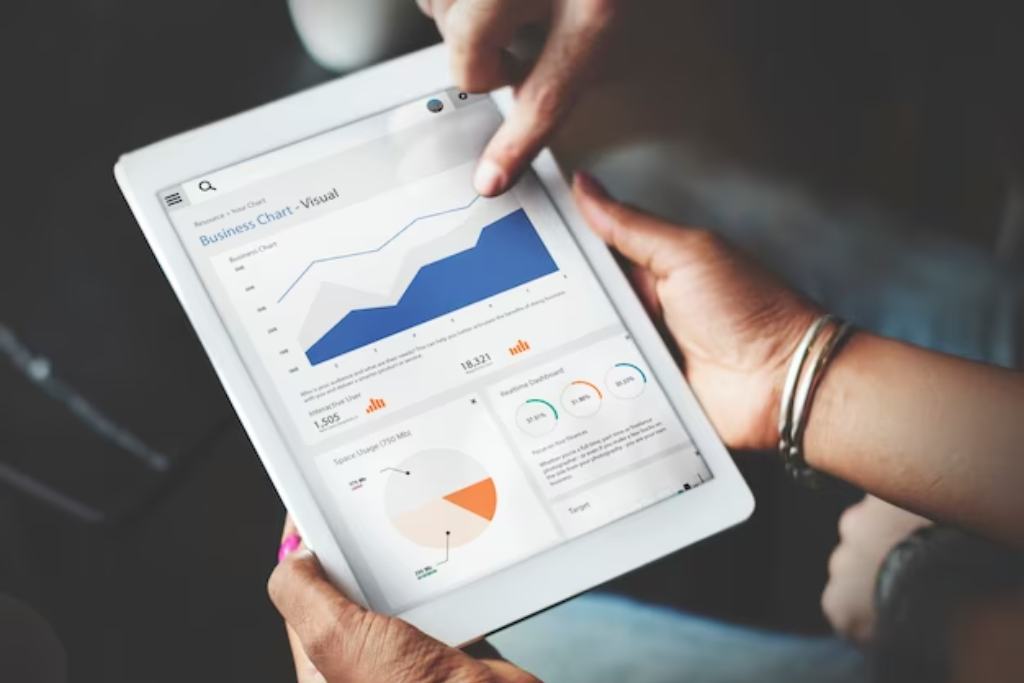Ready to take your marketing efforts to the next level? Look no further than Google Analytics, the ultimate tool for tracking and analyzing your marketing results. With its powerful features and user-friendly interface, Google Analytics provides invaluable insights into your website traffic, audience behavior, and conversion rates. Whether you’re a beginner or an experienced marketer, harnessing the power of this tool can revolutionize your digital strategy.

In this blog post, we’ll guide you through the process of setting up a Google Analytics account, navigating its dashboard, understanding key metrics, and using it to track your website traffic. We’ll also dive into more advanced techniques like custom reports and integrating Google Analytics with other marketing tools. So grab a cup of coffee (or tea) and get ready to unlock the full potential of Google Analytics for tracking your marketing results!
What is Google Analytics?
Google Analytics is a free web analytics tool that enables you to monitor and assess the performance of your website. It provides valuable insights into various aspects of your site, including visitor behavior, traffic sources, conversion rates, and much more.
With Google Analytics, you can gain a more profound understanding of who your audience is and how they interact with your website. You can track metrics like page views, bounce rate (the percentage of visitors who leave after viewing only one page), average time spent on the site, and the number of conversions.

The tool also enables you to identify which channels are driving traffic to your site, whether it’s through organic search results, social media platforms, or paid advertisements. This information helps you optimize your marketing efforts by focusing on the most effective channels.
One of the greatest benefits of using Google Analytics is its ability to provide real-time data. You can monitor live activity on your site and see immediate updates on visitor numbers and engagement metrics. This feature allows for quick adjustments in strategy if needed.
To start using Google Analytics to track your marketing results effectively, all you need to do is set up an account and install a tracking code on every page of your website. The code collects data as visitors browse through different pages, providing comprehensive insights into their journey.
Google Analytics offers marketers a wealth of data-driven insights into their website’s performance. By analyzing this information regularly and making informed decisions based on it, businesses can optimize their digital strategies for maximum impact!
Setting up a Google Analytics account
Setting up a Google Analytics account is the first step towards tracking your marketing results effectively. It allows you to gain valuable insights into your website’s performance and understand how visitors are interacting with your content.
To get started, visit the Google Analytics website and sign in using your Google account. If you don’t have one, create one for free. Once logged in, click on “Start measuring” and follow the prompts to set up your account.

Next, you need to add the tracking code to your website. This code will collect data about visitors’ behavior on your site and send it back to Google Analytics for analysis. Simply copy the provided tracking ID and paste it on every page of your website before the closing tag.
Once everything is set up, give it some time for data collection. You can then navigate through various reports within the Google Analytics dashboard to gain insights like the number of visitors, their demographics, bounce rate, conversion rates, and more. These metrics will help you evaluate the effectiveness of different marketing channels or campaigns.
In addition to the standard reports available in the GA dashboard, custom reports can be created based on specific goals or metrics that matter most to your business. This option provides deeper analysis by allowing you to define segments or dimensions according to individual requirements.
By integrating Google Analytics with other marketing tools like Google Ads or social media platforms such as Facebook or Twitter Ads Manager, you can further enhance its capabilities by gaining a holistic view of all marketing efforts under one roof.
Remember that setting up a Google Analytics account is just the beginning; regularly monitoring key metrics and making informed decisions based on data-driven insights will ultimately lead to better marketing strategies and improved results for your business!
Understanding the Dashboard and Key Metrics
When you first log into your Google Analytics account, you’ll be greeted with a dashboard that provides an overview of your website’s performance. This is where you can get a quick snapshot of important metrics such as the number of visitors, page views, bounce rate, and average session duration.
The dashboard is customizable, allowing you to choose which metrics are most relevant to your marketing goals. You can also set up custom alerts to notify you of any significant changes in these metrics.

One key metric to pay attention to is the acquisition report. This shows you how users are finding your website, whether it’s through organic search, paid advertisements, or social media referrals. This information can help guide your marketing strategies and allocate resources effectively.
Another important metric is the behavior report. This provides insights into how users interact with your site once they land on it. Are they viewing multiple pages? Are they leaving quickly without taking any action? Understanding user behavior can help identify areas for improvement on your website.
Conversion tracking is another powerful feature of Google Analytics. By setting up goals and tracking conversions, you can measure the effectiveness of different marketing campaigns and channels in driving desired actions from users.
In addition to these key metrics, Google Analytics offers a wide range of other reports that provide more granular data about demographics, devices used by visitors, referral sources, and much more.
By understanding these key metrics provided by the Google Analytics dashboard and diving deeper into specific reports tailored to your needs through customization options, you will gain valuable insights into how well your marketing efforts are performing.
The ability to track these metrics over time allows for continuous optimization and improvement in achieving desired results from various marketing initiatives
Using Google Analytics to track website traffic
Using Google Analytics to track website traffic is an essential tool for any marketer or business owner. It provides valuable insights into how visitors are interacting with your site, allowing you to make data-driven decisions and optimize your marketing efforts.
Once you have set up your Google Analytics account and added the tracking code to your website, you can start monitoring your website traffic. The dashboard provides a snapshot of key metrics such as the number of sessions, users, pageviews, bounce rate, and average session duration. These metrics give you a high-level overview of how well your website is performing.

Digging deeper into the data, you can explore which channels are driving the most traffic to your site. Are people finding you through organic search, social media, or paid advertising? Understanding this information helps you allocate resources effectively and identify opportunities for improvement.
Another useful feature of Google Analytics is the ability to track specific goals or events on your website. Whether it’s newsletter sign-ups or completed purchases, setting up goal tracking allows you to measure conversions and analyze user behavior throughout their journey on your site.
In addition to standard reports provided by Google Analytics, custom reports offer even more in-depth analysis tailored to specific business needs. You can create custom reports that focus on specific segments of users (such as new vs. returning visitors) or drill down into particular dimensions like geographic location or device type.
Integrating Google Analytics with other marketing tools further enhances its capabilities. By linking it with platforms like Google Ads or email marketing software, you can gain a holistic view of how different campaigns are contributing towards generating traffic and conversions on your site.
To maximize the effectiveness of Google Analytics:
- Regularly review and analyze the data: Set aside time each week or month to examine trends and identify areas for improvement.
- Utilize annotations: Add notes within Google Analytics when significant changes occur (e.g., launching a new campaign), so historical context is maintained.
- Take advantage of advanced features: Explore features like cohort analysis, user flow visualization, and attribution modeling to gain
Utilizing custom reports for more in-depth analysis
Custom reports in Google Analytics allow marketers to dive deeper into their data and extract valuable insights for more effective marketing strategies. These reports provide a comprehensive view of specific metrics that align with your business goals, allowing you to analyze and measure the success of your marketing efforts.

One key benefit of custom reports is the ability to focus on specific segments or dimensions. By defining custom parameters such as location, device type, or referral source, you can gain a better understanding of how different audience segments interact with your website. This information can help you tailor your marketing campaigns to target specific demographics or optimize the user experience based on device preferences.
Another advantage of utilizing custom reports is the ability to cross-reference different metrics. For example, by combining data from page views and conversion rates, you can identify pages that are driving the most conversions and optimize them further for better results. This kind of analysis allows you to make informed decisions about where to allocate resources and prioritize areas for improvement.
In addition, custom reports enable marketers to track specific goals or events within their website. Whether it’s tracking newsletter sign-ups or e-commerce transactions, setting up custom event tracking provides valuable insights into user behavior and engagement levels across various touchpoints in their journey.
By leveraging these customized reporting features in Google Analytics, marketers can gain a more holistic understanding of their marketing efforts’ performance. The granular insights obtained through these tailored reports empower businesses to refine their strategies continuously and optimize ROI.
Remember: Customizing your reporting framework according to your unique needs will ensure that you’re extracting relevant data points for actionable analysis! So don’t be afraid to explore the realm of possibilities offered by Google Analytics’ customization options—it’s an invaluable tool for enhancing your marketing effectiveness!
Integrating Google Analytics with other marketing tools
Integrating Google Analytics with other marketing tools can provide a comprehensive view of your marketing efforts and help you make data-driven decisions. By combining the power of Google Analytics with other tools, you can gain valuable insights into how your different marketing channels are performing and optimize your strategies accordingly.

One way to integrate Google Analytics is by connecting it with your email marketing platform. This allows you to track the effectiveness of your email campaigns, such as open rates, click-through rates, and conversions. By analyzing this data alongside other metrics in Google Analytics, like website traffic and goal completions, you can determine which emails are driving the most engagement and ultimately leading to conversions.
Another tool that can be integrated with Google Analytics is social media management software. By linking these two platforms together, you can track the impact of your social media efforts on website traffic and conversions. You’ll be able to see which social media channels are driving the most engaged visitors to your site and adjust your strategy accordingly.
Furthermore, integrating Google Ads with Google Analytics enables you to analyze not only ad performance metrics but also user behavior after clicking on an ad. With this integration in place, you can identify which keywords or ads are generating high-quality leads or sales for your business.
In addition to these integrations, there are numerous third-party tools available that offer seamless integration with Google Analytics. These tools allow for deeper analysis of specific aspects of your marketing efforts, such as SEO performance or content analytics.
By integrating various marketing tools with Google Analytics, you’ll have a comprehensive understanding of how each channel contributes to overall success. This holistic approach empowers marketers to make informed decisions based on real-time data rather than relying solely on gut instincts or assumptions.
Explore the article “How to Use YouTube Automation Tools to Boost Your Earnings and Grow Your Channel” for more information on creative ways to improve your online presence and maximize the impact of your marketing efforts through the use of strategic automation on YouTube.
